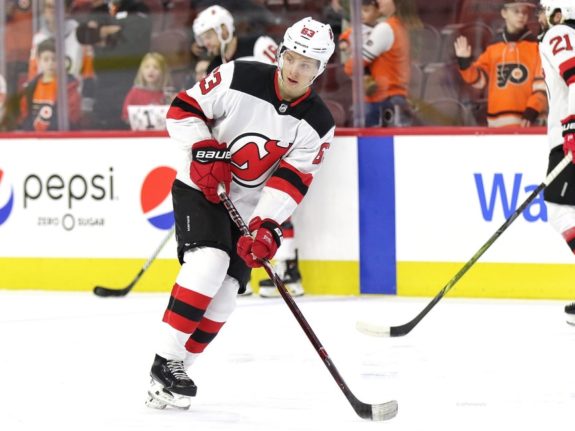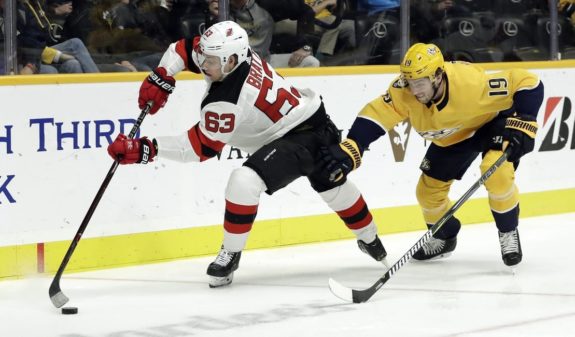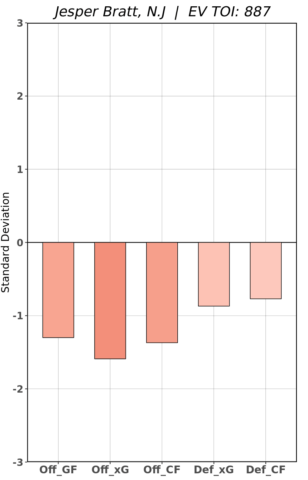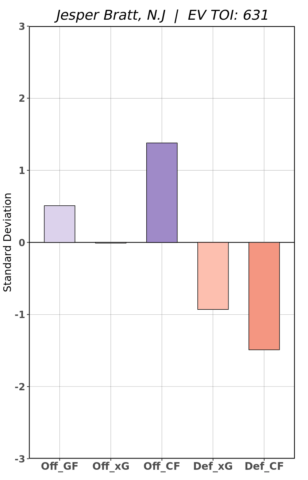When Ray Shero took over as New Jersey Devils’ general manager, one thing on top of his to-do list was rebuild a farm system that had been left barren by the previous regime. The first draft class with his staff in place came in 2016, where they took Michael McLeod with the 12th overall pick. But so far, it’s not McLeod who’s been the star of that class; instead, it’s been Jesper Bratt, who was a sixth-round selection (162nd overall).
Now entering his third pro season, Bratt has become one of the Devils’ top players 21 years old or younger. He took a step forward in 2018-19 on a team that was decimated by injuries. So can he solidify his spot as a top-six forward as the team looks to once again become players in the Metropolitan Division?
Bratt’s Progress a Season Ago
Bratt got off to a scorching hot start as a rookie with the Devils in 2017-18, totaling 12 goals and 30 points in his first 44 games. However, he had a lot of luck on his side as he shot 18.5% over those first 44 games. His five-on-five shot rates weren’t great, either, as he had a Corsi for percentage (CF%) of 47.73% and expected goals for percentage (xGF%) of 46.93%.
Those shot rates and some bad luck caught up to him in the second half of the season. He had 1 goal and 5 points over his last 30 games and shot just 2.9% while firing 35 shots on goal. It was the first time in his career he played a season as long as the NHL’s. And it seems the wear-and-tear of the schedule affected him mentally.

Even though Bratt’s second half didn’t go as he wanted, it was clear he had potential. The hope was for another hot start to 2018-19, but one he could sustain. Unfortunately, he missed the beginning of the season after fracturing his jaw in an unfortunate accident during one of the team’s practices while they were in Europe.
When he returned to action, he looked like a different player. He had 13 points his first 17 games back from the injury, and his shot rates improved by quite a bit — he had a 52.29 CF% and a 49.37 xGF%. He went through a minor lull, with no points in his next six games, but finished with 20 points over his final 28 games before an injury ended his season.
His final stat line came out to 33 points in 51 games, which translates to a 53-point pace over 82 games. And he averaged 2.23 points per 60 minutes (P/60), ranked second to Taylor Hall on the team. Bratt’s five-on-five impact was noticeably better than it was the previous season, too.
In 2017-18, Bratt struggled on both offense and defense, whether it was with shot attempts (Off_CF, Def_CF) or expected goals (Off_xG, Def_xG). While his defense didn’t see much improvement in 2018-19, he made substantial gains on offense as he had a positive impact on Off_CF and scoring goals. So that should bode well heading into the new season.
Cut out for a Top-Six Role
Bratt has moved around the lineup since making his NHL debut. With his strong close to last season, he seems ready to lock down a spot on one of the Devils’ scoring lines. They may be a much-improved team after a busy offseason, but he has a couple of things working in his favor.
He has experience with two of the Devils’ best players, Taylor Hall and Nico Hischier. Over the last two seasons, the three have played 386 minutes together at five-on-five across 83 games, and their results are encouraging — they have a 49.59 CF% and a 53.58 xGF% together. They’ve also controlled a majority of scoring and high-danger chances. So if head coach John Hynes is looking for a top line, this trio could be a place to start.
Related: Devils’ Top 10 Prospects: Preseason 2019
Another thing Bratt has working in his favor is his versatility. He’s a left-handed shot but has played both left and right-wing. His pass-first mentality would make him a good choice as a left-wing opposite Kyle Palmieri, who’s one of the top shooting talents in the NHL. If Hynes decides to give Wayne Simmonds — who they signed as a free agent this summer — a shot in the top-six, Bratt could play alongside him as well.

If there’s something that may prevent Bratt from consistent top-six minutes, it’s his defense. With that said, the Devils won’t be looking for him to shut down opponent’s top lines. And Hynes knows that, too. He’ll likely keep Bratt sheltered, meaning he’ll see favorable offensive minutes, which is the best way to get the most out of him.
Related: The Best Rookie Seasons in NHL History
The Devils only scored 226 goals last season, which was fifth-worst in the NHL, so they have a lot of ground to cover to return to the playoffs. They don’t need Bratt to be an 80-point scorer to make that up, especially after their offseason additions. But he is an essential player, and they need him to continue to build on what he did in 2018-19. Fortunately, it doesn’t look like it was a fluke, so he should help give their offense the lift it needs to be a legitimate threat.
* * *
Advanced stats from Natural Stat Trick, RAPM charts from Evolving Hockey

